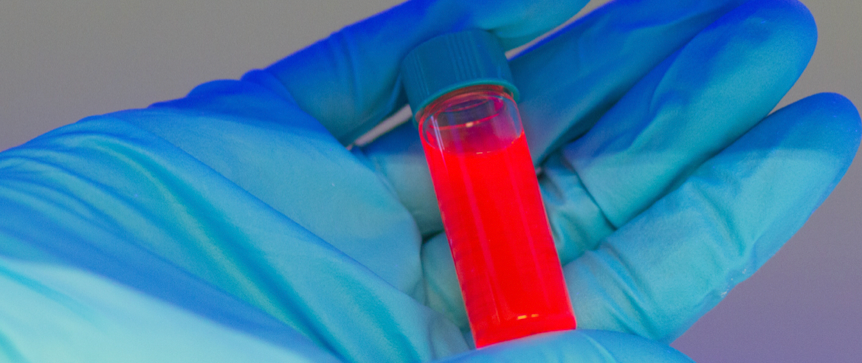
Efficiently turning light into electricity
New research has now shown that certain perovskites in fact do have this desirable property
Table of Contents
Perovskites form a group of crystals that have many promising properties for applications in nano-technology. However, one useful property that so far was unobserved in perovskites is so-called carrier multiplication – an effect that makes materials much more efficient in converting light into electricity. New research performed in collaboration between the University of Amsterdam (UA) and Osaka University (OU) and led by prof. Tom Gregorkiewicz (UA, OU) and prof. Yasufumi Fujiwara (OU), has now shown that certain perovskites in fact do have this desirable property.
Crystals are configurations of atoms, molecules or ions, that are ordered in a structure that repeats itself in all directions. We have all encountered some crystals in everyday life: ordinary salt, diamond and even snowflakes are examples. What is perhaps less well-known is that certain crystals show very interesting properties when their size is not that of our everyday life but that of nanometers – a few billionths of a meter. There, we enter the world of nanocrystals, structures that have shown to be extremely useful in constructing technological applications at tiny scales.
Perovskites – named after 19th century Russian mineralogist Lev Perovski – form a particular family of nanocrystals that all share the same crystal structure. At the nanoscale, these perovskites have many desirable electronic properties, making them useful for constructing for example LEDs, TV-screens, solar cells and lasers. For this reason, in the past years perovskite nanocrystals have been studied extensively by physicists.
Carrier multiplication
A property which so-far had not been shown to exist in perovskites is carrier multiplication . When nanocrystals – in solar cells, for example – convert the energy of light into electricity, this is usually done one particle at a time: a single infalling photon results in a single excited electron (and the corresponding “hole” where the electron used to be) that can carry an electrical current. However, in certain materials, if the infalling light is energetic enough, further electron-hole pairs can be excited as a result; it is this process that is known as carrier multiplication.
When carrier multiplication occurs, the conversion from light into electricity can become much more efficient. For example, in ordinary solar cells there is a theoretical limit (the so-called Shockley-Queisser limit) on the amount of energy that can be converted in this way: at most a little of 30% of the solar power gets turned into electrical power. In materials that display the carrier multiplication effect, however, an efficiency of up to 44% has already been obtained.
PhD
This makes it very interesting to search for the carrier multiplication effect in perovskites as well, and that is precisely what dr. Chris de Weerd and dr. Leyre Gomez from the Optoelectronic Materials group led by prof. Tom Gregorkiewicz, in collaboration with the group of prof. Yasufumi Fujiwara, and with support of their colleagues from the National AIST Institute in Tsukuba and Technical University Delft have now done. Using spectroscopy methods – studying the frequencies of the radiation that comes from a material after very briefly illuminating it with a flash of light – the researchers showed that a perovskite nanocrystals made out of cesium, lead and iodine, do indeed display carrier multiplication. Moreover, they argue that the efficiency of this effect is higher than reported thus far for any other materials; with this finding therefore the extraordinary properties of perovskite receive a new boost!
De Weerd, who successfully defended her PhD thesis based on this and other research last week, says: “Until now, carrier multiplication had not been reported for perovskites. That we have now found it is of great fundamental impact on this upcoming material. For example, this shows that perovskites can be used to construct very efficient photodetectors, and in the future perhaps solar cells.”

Image:
Dr. Leyre Gomez (right) and Dr. Chris de Weerd (left) with a sample of the studied material.
(Credit: the University of Amsterdam)
Reference
The paper in which the researchers report on their findings was published in Nature Communications .
Efficient carrier multiplication in CsPbI3 perovskite nanocrystals , C. de Weerd, L. Gomez, A. Capretti, D. Lebrun, E. Matsubara, J. Lin, M. Ashida, F. Spoor, L. Siebbeles, A. Houtepen, K. Suenaga, Y. Fujiwara and T. Gregorkiewicz, Nature Communications, https://doi.org/10.1038/s41467-018-06721-0 .
Article : Efficient carrier multiplication in CsPbI3 perovskite nanocrystals
Journal : Nature Communications
DOI : 10.1038/s41467-018-06721-0
Authors : C. de Weerd, L. Gomez, A. Capretti, D. Lebrun, E. Matsubara, J. Lin, M. Ashida, F. Spoor, L. Siebbeles, A. Houtepen, K. Suenaga, Y. Fujiwara and T. Gregorkiewicz
Funding : Dutch Technology Foundation STW, Netherlands Organization for Scientific Research (NWO), Japan Science and Technology Agency(JST)-ACCEL, Japan Society for the Promotion of Science (JSPS)
Related links
